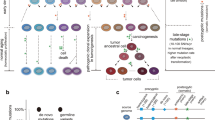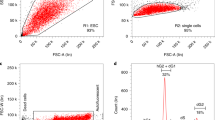Abstract
Chromosomal deletions (‘deficiencies’) are powerful tools in the genetic analysis of complex genomes. They have been exploited extensively in Drosophila melanogaster, an organism in which deficiencies can be efficiently induced and selected1. Spontaneous deletions in humans have facilitated the dissection of phenotypes in contiguous gene syndromes2,3 and led to the positional cloning of critical genes4,5. In mice, deletion complexes created by whole animal irradiation experiments have enabled a systematic characterization of functional units along defined chromosomal regions6,7. However, classical mutagenesis in mice is logistically impractical for generating deletion sets on a genome-wide scale. Here, we report a high-throughput method for generating radiation-induced deletion complexes at defined regions in the genome using ES cells. Dozens of deletions of up to several centiMorgans, encompassing a specific locus, can be created in a single experiment and transmitted through the germline. The ability to rapidly create deletion complexes along chromosomes will facilitate systematic functional analyses of the mammalian genome.
This is a preview of subscription content, access via your institution
Access options
Subscribe to this journal
Receive 12 print issues and online access
$209.00 per year
only $17.42 per issue
Buy this article
- Purchase on Springer Link
- Instant access to full article PDF
Prices may be subject to local taxes which are calculated during checkout
Similar content being viewed by others
References
Ashburner, M. Drosophila A Laboratory Manual. (Cold Spring Harbor Laboratory Press, Cold Spring Harbor, New York, 1989).
Schmickel, R.D. Contiguous gene syndromes: a component of recognizable syndromes. J. Pediatr. 109, 231–241 (1986).
Overhauser, J. et al. Molecular and phenotypic mapping of the short arm of chromosome 5: sublocalization of the critical region for the cri-du-chat syndrome. Hum. Mol. Genet. 3, 247–252 (1994).
Sinclair, A.H. et al. A gene from the human sex-determining region encodes a protein with homology to a conserved DMA-binding motif. Nature 346, 240–244 (1990).
Page, D.C. et al. The sex-determining region of the human Y chromosome encodes a finger protein. Cell 51, 1091–1104 (1987).
Russell, L. Montgomery, C . & Raymer, G. Analysis of the albino-locus region of the mouse: IV. Characterization of 34 deficiencies. Genetics 100, 427–453 (1982).
Holdener-Kenny, B. Sharan, S.K. & Magnuson, T. Mouse albino-deletions: from genetics to genes in development. Bioessays 14, 831–839 (1992).
Urlaub, G. et al. Effect of gamma rays at the dihydrofolate reductase locus: deletions and inversions. Som. Cell. Mol. Genet. 12, 555–566 (1986).
Kavathas, P. Bach, F. & DeMars, R. Gamma ray-induced loss of expression of HLA and glyoxalase I alleles in lymphoblastoid cells. Proc. Natl. Acad. Sci. USA 77, 4251–4255 (1980).
teRiele, H. Maandag, E. & Berns, A. Highly efficient gene targeting in embryonic stem cells through homologous recombination with isogenic DNA constructs. Proc. Natl. Acad. Sci. USA 89, 5128–5132 (1992).
Hamvas, R. et al. Mouse Chromosome 17. Mamm. Genome 6, S281–S299 (1996).
Johnson, D.R. Hairpin-Tail: a case of post-reductionaI gene action in the mouse egg? Genetics 76, 795–805 (1974).
Askew, G. Doetschman, T. & Lingrel, J. Site-directed point mutations in embryonic stem cells: a gene-targeting tag-and-exchange strategy. Mol. Cell. Biol. 13, 4115–4124 (1993).
Ramirez Solis, R. Liu, P. & Bradley, A. Chromosome engineering in mice. Nature 378, 720–724 (1995).
Holdener, B.C. et al. Physical localization of eed: a region of mouse chromosome 7 required for gastrulation. Genomics 27, 447–456 (1995).
Rinchik, E.M. Carpenter, D.A. & Long, C.L. Deletion mapping of four loci defined by N-ethyl-N-nitrosourea-induced postimplantation-lethal mutations within the pid-Hbb region of mouse chromosome 7. Genetics 135, 1117–1123 (1993).
Rinchik, E.M. & Carpenter, D.A. N-ethyl-N-nitrosourea-induced prenatally lethal mutations define at least two complementation groups within the embryonic ectoderm development (eecO locus in mouse chromosome 7. Mamm. Genome 4, 349–353 (1993).
Swiatek, P.J. & Gridley, T. Perinatal lethality and defects in hindbrain development in mice homozygous for a targeted mutation of the zinc finger gene Krox20. Genes Dev. 7, 2071–2084 (1993).
Dietrich, W. et al. A genetic map of the mouse with 4,006 simple sequence length polymorphisms. Nature Genet. 7, 220–245 (1994).
Dietrich, W.F. et al. A comprehensive genetic map of the mouse genome. Nature 380, 149–152 (1996).
Gregorova, S. et al. Sub-milliMorgan map of the proximal part of mouse Chromosome 17 including the hybrid sterility 1 gene. Mamm. Genome 7, 107–113 (1996).
Hammer, M.H. Schimenti, J.C. & On the origins of t complex inversions. Proc. Natl. Acad. Sci. USA 86, 3261–3265 (1989).
Sharan, S.K. et al. The albino-deletion complex of the mouse: molecular mapping of deletion breakpoints that define regions necessary for development of the embryonic and extraembryonic ectoderm. Genetics 129, 825–832 (1991).
Bell, J.A. Rinchik, E.M. Raymond, S. Suffolk, R. & Jackson, I.J. A high-resolution map of the brown (b, Tyrp1) deletion complex of mouse chromosome 4. Mamm. Genome 6, 389–395 (1995).
Author information
Authors and Affiliations
Rights and permissions
About this article
Cite this article
You, Y., Bergstrom, R., Klemm, M. et al. Chromosomal deletion complexes in mice by radiation of embryonic stem cells. Nat Genet 15, 285–288 (1997). https://doi.org/10.1038/ng0397-285
Received:
Accepted:
Issue Date:
DOI: https://doi.org/10.1038/ng0397-285
This article is cited by
-
The art and design of genetic screens: mouse
Nature Reviews Genetics (2005)
-
X-ray-induced deletion complexes in embryonic stem cells on mouse chromosome 15
Mammalian Genome (2005)
-
Transgenic rescue of the mouse t complex haplolethal locus Thl1
Mammalian Genome (2005)
-
Tailoring the genome: the power of genetic approaches
Nature Genetics (2003)
-
DelBank: a mouse ES-cell resource for generating deletions
Nature Genetics (2001)



